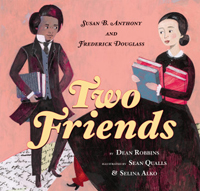 Dean Robbins is an award-winning writer based in Madison, WI. His first book, Two Friends, chronicles a conversation between suffragist Susan B. Anthony and abolitionist Frederick Douglass over tea. With vibrant illustrations and actual quotes from the two historical figures, Two Friends is a heartening tale of friendship that introduces important historical topics in an approachable way for all ages. Be sure to check out the accompanying Reading Guide for instructional ideas.
Dean Robbins is an award-winning writer based in Madison, WI. His first book, Two Friends, chronicles a conversation between suffragist Susan B. Anthony and abolitionist Frederick Douglass over tea. With vibrant illustrations and actual quotes from the two historical figures, Two Friends is a heartening tale of friendship that introduces important historical topics in an approachable way for all ages. Be sure to check out the accompanying Reading Guide for instructional ideas.
The premise of Two Friends was inspired by a statue of Susan B. Anthony and Frederick Douglass in their hometown of Rochester, NY. How did you come across this statue, and what about it was so moving to you?
I’m dedicated to my personal pantheon of heroes, and that involves traveling to their hometowns in hopes of feeling their presence. In this case, I took a road trip to Rochester because I knew that both Susan B. Anthony and Frederick Douglass had lived there, making it sacred ground to me. On a tour of the Susan B. Anthony House, the guide mentioned that Anthony often invited her neighbor Douglass to sit in her parlor for tea. The tour also included a look at the statue of the two friends having tea in a nearby park.
As much as I’d read about 19th-century reform movements, I didn’t know that Anthony and Douglass lived so close to each other and socialized. It was stunning to think that two of the world’s greatest champions of freedom shared ideas, worked together, and supported each other over tea. I’d felt similarly elated as a kid when I read comic books in which Batman and Superman teamed up as an invincible pair. It seemed too good to be true.
Sean Qualls and Selina Alko, both of whom will be appearing at ILA 2017 this July, illustrated Two Friends. How would you describe the interplay between your text and their mixed media illustrations?
Two Friends is less a straight biography of Anthony and Douglass than a poetic evocation of their tea party on a snowy day. The friends enjoy a moment of serenity before going out, once again, to face adversity and change the world. With painterly richness, Sean and Selina brought this mood to life. They also included so many lovely details that I discover new ones every time I pick up the book.
Their masterstroke was embedding words within the images: bits of printed and handwritten text that show up in clothing, trees, snow—even butterfly wings. This design element is visually striking but also thematically relevant. In the book, Anthony and Douglass are always reading, writing, and talking about freedom and equality. The text-drenched images emphasize that Two Friends is a story about the awesome power of words.
Two Friends is geared toward readers ages 4 to 8. What compelled you to write this particular story for this particular audience?
Anthony and Douglass are among the bravest heroes in U.S. history. In spite of fierce opposition, they insisted that the country live up to the highest ideals of the Declaration of Independence and the Constitution. It’s important that children learn about them at an early age, but concepts like abolition and women’s suffrage can be difficult to explain to elementary school students. That’s why I liked the idea of a tea party. If kids have a hard time grasping 150-year-old political issues, I know they can relate to two friends coming together for the grown-up version of a playdate.
Kids are also very sensitive to unfairness. Two Friends introduces Anthony and Douglass’s egalitarian vision without delving into details that might be confusing for young readers.
 This book was written long before the contentious 2016 presidential election in the United States, yet could not feel more timely. How has the current cultural climate generated new interest in the year-old publication?
This book was written long before the contentious 2016 presidential election in the United States, yet could not feel more timely. How has the current cultural climate generated new interest in the year-old publication?
Two Friends is probably getting this kind of attention because it’s clearer than ever that Anthony and Douglass’s work remains unfinished. They championed the dignity of all people and showed what’s possible when oppressed groups refuse to be dominated. If they were alive, they’d surely try to level the playing field for every citizen. In that sense, they can inspire today’s activists who want to make the United States a better place.
Which historical figure would you most want to have a tea party with, and why?
My heroes include Louis Armstrong, Abraham Lincoln, Alice Paul, Emily Dickinson, the Grimké Sisters, and Jackie Robinson, and I’d happily sit down for tea and cake with any of them. But the first names on my fantasy guest list would be Susan B. Anthony and Frederick Douglass. There’s little documentation of what they said to each other during their tea parties in Rochester, and I’d give anything to eavesdrop!
Clare Maloney is an intern at the International Literacy Association. She is currently seeking a BA in English from the University of Delaware.